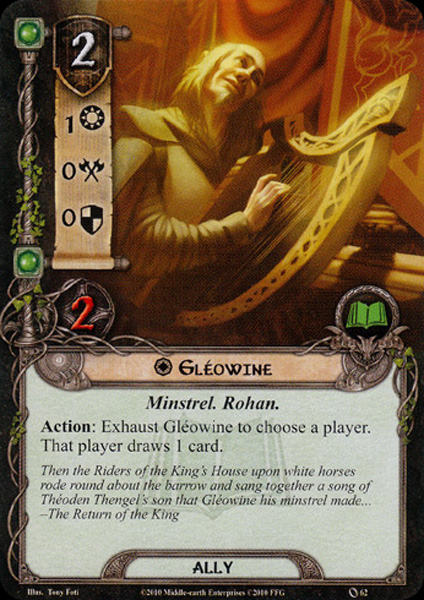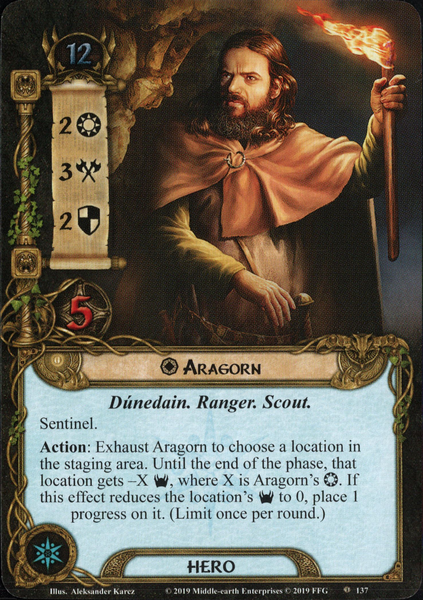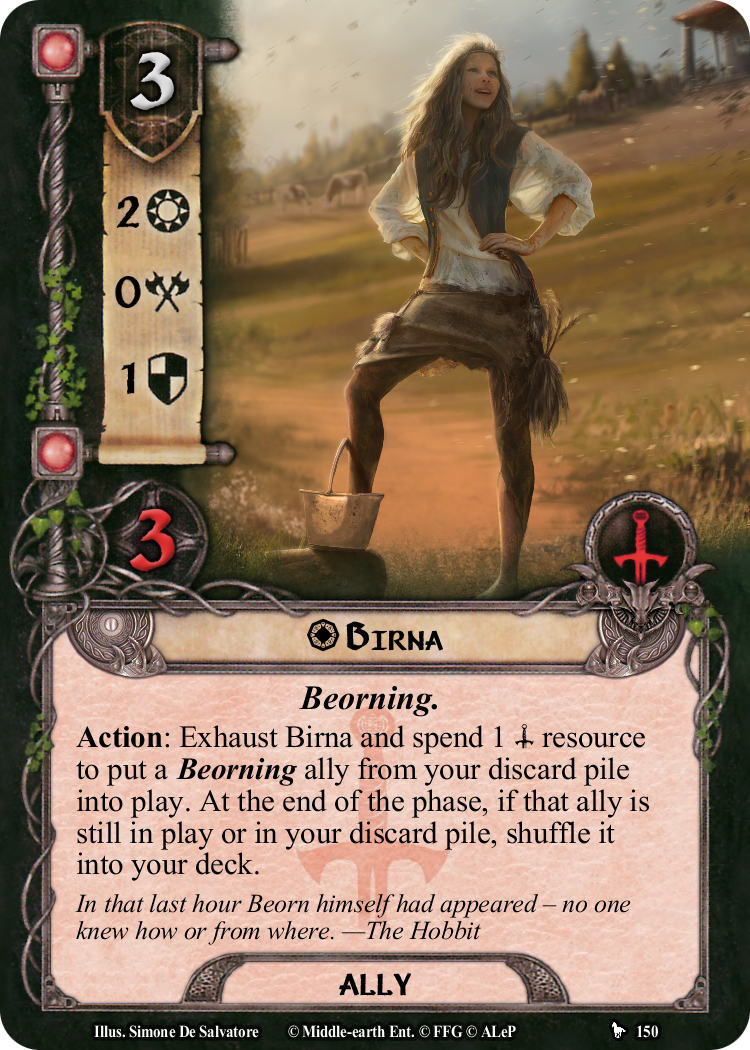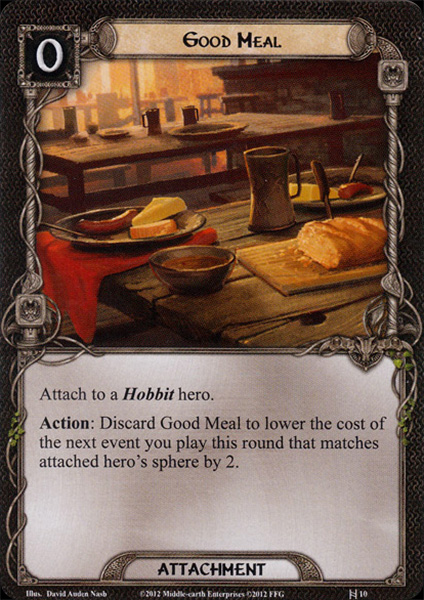This card is so satisfying to pull off. But then, if I like it so much, why don't I put it in more decks? I was thinking about that recently, and I think I figured out why: the most common point of this card is to prevent an enemy from attacking you (by attacking and destroying it first); but the thing is, Feint accomplishes exactly the same thing but better. With Feint, you don't have to be able to kill the enemy right away in order to stop its attack, and then you can gang up with as many allies as you want to attack it. Plus you can use Feint to help another player, which you can't with Quick Strike unless you have a Ranged character. I think the only advantages Quick Strike has over Feint are 1) being able to trigger your "when this character attacks/defeats an enemy" abilities whenever you want, and 2) being able to attack quest-related enemies early to advance the quest before the combat phase. But from my experience these two situations are few and far between enough that I've always been happy to draw Feint in almost every case, while so many things have had to go right in order for Quick Strike to be useful for me when I draw it.
Recently I've found a great combo for Gléowine in one of my RCO decks: use hero Faramir and play Leather Boots on Gléowine. Here's best case scenario:
- Draw a card with Gléowine.
- If you reveal a location, ready Gléowine with Leather Boots and draw another card.
- If you engage an enemy the same turn, ready him again with Faramir and draw another card.
- If you have Ever Vigilant in your deck, play it on Gléowine and draw another card!
This way you can draw 4 cards in one round with him. Sometimes even more if you engage enemies in different phases somehow and use Faramir's ability.
A very powerful and underrated version of Aragorn.
Versatility
With a stat-line that can do any job, being in the sphere of Unexpected Courage helps him a lot. Choosing what to do with him in the first few turns is critical for all versions of Aragorn. With his ability you can wait until after the encounter deck reveal to determine what to do. Did you reveal an enemy you need to fight? He's still ready! Did you reveal a location? You can use his ability to add his willpower to questing anyway.
But it gets better: did you keep him in reserve for combat, but find yourself just short of willpower to clear the active location or to put progress on the quest? There are situations where this gamble can cost you the game. Think of locations such as Lightless Grotto, Ancient Guardroom, Ithilien Road or Quests such as Breaking of the Fellowship 1b, or the quests from the Harad cycle. Aragorn can give you that final boost.
Or if maybe you want to build your board state and not advance the quest, but still keep clearing locations. You can underquest and if you get a low threat enemy or treachery, you don't accidentally advance. Aragorn ability to control your questing power is unmatched and you need to play with him to really appreciate.
And there are more creative ways to use his ability. Any location that triggers on "when this location is explored" can be timed by using his ability to place progress. In one instance I used it to explore a location with Elf-stone on it to put Jubayr into play after my current copy in play was just defeated in order to block another enemy.
Questing power
Aragorn is one of very few heroes that can quest twice using Unexpected Courage. He can quest AND use his ability to use his willpower again. This let's him get double effectiveness from willpower boosts. Add the fact that he can put progress on the location and he's also questing for future turns. In 3 or 4 player games, being able to explore locations in the staging area is very powerful and having a hero capable of such feats from turn 1 is great. Add Rhovanion Outrider or Northern Tracker and you're in great shape.
Tools
Being Aragorn, there are a lot of useful attachments specifically for him. Ring of Barahir is in sphere and a great addition if you are also playing with lore. You'll want more artifacts on him then and Mithril Shirt and Stone of Elostirion are both amazing on him and because they are guarded by locations, they play into his strengths. Even better, they discard non-locations from the encounter deck so the rest of the deck is more likely to hand you more locations. This also lets you lean into The One Ring and Well Preserved. Sword that was Broken is the best Aragorn attachment and can be played with Reforged** provided you have means to discard it from your hand with cards like Arwen Undómiel or Éowyn. Thorongil gives you access to tactics Aragorn abilities to help your spirit deck deal with enemies but lore Aragorn and his threat reduction can come in clutch as well.
Downsides
Aragorn flexibility at the start is great, but you'll also need it due to his high starting threat.
His other weakness is that his ability requires targetable locations in the staging area. In 3 or 4 player games this shouldn't be a problem but in solo play you'll want to keep a location in the staging area or use cards like A Watchful Peace, Shadow of the Past or The Hidden Way to be sure. This, along with the other tools we mentioned, means he'll want to take a sizable chunk of your deckspace for support.
** Apparently Reforged got errata in the repackaging. But I 100% believe Sword that was Broken should be an 'item' and usable with this card for obvious reasons.
This card can be pretty useful in decks that have Beorning allies! Let’s say a Giant Bear was destroyed during combat, then the next round you can exhaust Birna to put Giant Bear back into play for one round only for one resource! At the end of the round instead of the Giant Bear being in your discard pile, he’s in your deck to draw him up again. I say a Giant Bear in play for one round for one resource is a pretty good deal for me! But there are tons of other great targets for Birna’s ability than just the Giant Bear. For example, there’s Beorning Skin-changer and Beorn himself! There’s lots of cool options with this card.
What about this card? I put it in ever deck with a ln hobbit hero!! This attachment can reduce a lot of expensive event like the gratis hunt! I play correct or i did a mistake? And with erebor hammersmith i can retake it and replay more times




